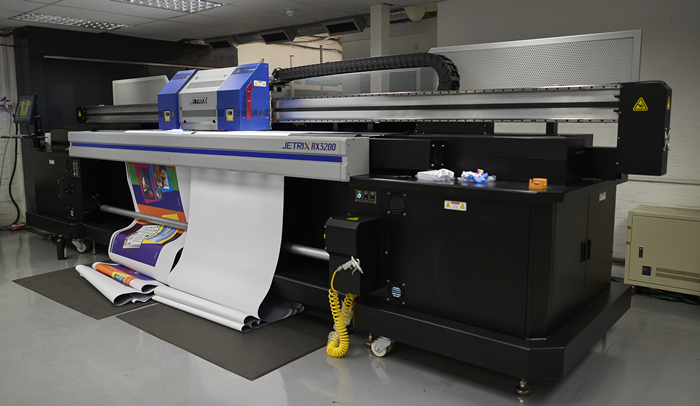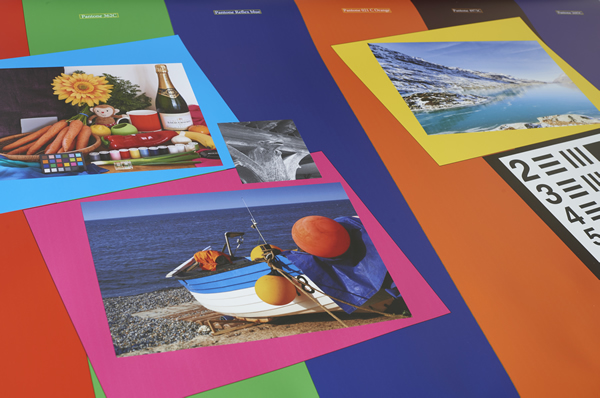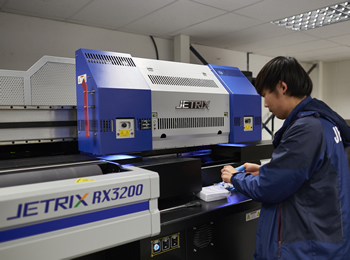Having been impressed with the Jetrix flatbed he tested last year Nessan Cleary went to see if the new roll-to-roll printer would be as good.
Korean company Inktec has built up a good reputation for its Jetrix range of UV-curable printers. Last year Image Reports tested one of the flatbeds and booked a return trip earlier this year when Inktec announced a couple of UV-curable roll-to-roll printers in the run up to Fespa 2015. The RX3200 on test this time around, is a 3.2m wide printer. There’s also a 5m wide version, the RX5000, which was shown on the Jetrix stand at Fespa 2015, though Ben Woodruff, sales manager at Inktec Europe, believes that the 3.2m machine will prove more popular here in the UK.
The RX3200 is a large machine that’s clearly aimed at the production end of the market with a maximum print speed of 222m2/hr in Production mode (this is up from the original specification thanks to new firmware). Woodruff says: “We have tried to embrace high quality and speed, which is the holy grail.”

It will handle most roll-fed materials up to 10mm thick and there’s an optional mesh kit for textiles and mesh substrates, which lifts the heads up and adds a sacrificial material.
Naturally, the inks come from Inktec and are tailored for the machine. Woodruff says: “It’s quite a flexible ink.” Curing is via Honle UV lamps.
The printer uses Konica Minolta 1024 printheads, which have a fixed 14 picolitre droplet size with a maximum resolution of 846 x 1440dpi. Inktec has used these heads on its earlier 2030 printer and Woodruff estimates that they should last two to three years, though as always with inkjet heads, the more careful you are to keep them clean and follow the maintenance procedures, the longer the heads will last.
Inktec has also looked at the KM1024i heads but Woodruff says that although these are faster there’s no benefit in terms of image quality and they may push the price up. There’s an argument that the printer is already quite fast, given that there are 16 heads fitted.
There’s a choice of two ink configurations. The fastest is all CMYK, with four heads per colour, but there’s also an option to have eight colours using light cyan, light magenta, light yellow and light black, with two heads per colour. Inktec is also planning to bring out a lower cost option with fewer heads.
Woodruff says that it’s easy enough to change between configurations and takes about an hour to flush the inks out. Naturally the all-CMYK is twice as fast, but having the eight colours does help with the colour gamut. Inktec is also developing a white option. Woodruff says there's no need for a primer because the ink has good adhesion to a wide range of substrates.
Loading is from the back of the machine and appears to be fairly straightforward. The feed roll has an air shaft to make it easier to load, and is quite low down on the machine. Naturally, as well as 3.2m wide substrates it will also print simultaneously to two smaller rolls side by side.

The maintenance is fairly simple, as with most UV printers. There's a capping station on the left side, where the print carriage comes to rest and a maintenance station on the right side. This later is hidden underneath a cover that slides off so that the operator can reach up into it.
The heads need to be wiped over at the start of each day, which is done manually. Operators can also print a nozzle test, to check there are no missing nozzles, and a head alignment test. It also has automatic inline nozzle cleaning, which blows ink through the nozzles to clear away any dirt. There are ink filters that need replacing every three to six months depending on the volume of work.
It’s worth noting that it does need a three phase power supply and a supply of compressed air.
The price does not include a Rip, with Woodruff pointing out that many customers will already have other devices and Rips that they would prefer to use. However, Inktec has an OEM agreement with GMG to use its ProductionSuite. Woodruff says: “We find that because GMG use a different Rip engine to the other Rips it processes data a lot faster.” He says this processing speed is important to ensure that the Rip keeps up with the printer, adding: “A lot of the jobs are going to be big banners with quite large files and ProductionSuite seems to just churn through these very quickly.”
ProductionSuite also offers the ability to fine-tune the spot colours. Operators can print off a chart with different patches representing different interpretations of the chosen spot colour and ask the customer to choose which colour they like best.
ON TEST
For our standard test we use two A0-sized charts, one with mainly solid Pantones, and one with mainly photographs. The machine that we tested was set up with the full eight-colour inkset and we printed our test charts to 190gsm satin paper. We printed each chart once at the highest quality setting that was available, which was four passes at 1440 x 846dpi, as well as at a standard production speed, which in this case was two passes at 846 x 720dpi.
Both charts printed at the same speed, despite having different ink coverage. Thus the two-pass mode took 4.20 minutes and four-pass took 7.48 minutes. However, the timings are really only a guide as the printer was set up with two 107cm rolls side by side so we printed the image in portrait mode. But it’s a 3.2m printer and with a wider roll we could have turned the images to landscape, which would have produced faster timings.
Unfortunately, neither the machine nor the Rip recorded the amount of ink used for these prints though Woodruff estimates that the Hiqh Quality print mode uses £1 of ink per square metre.
It’s difficult to properly evaluate the two-pass prints as the printer had suffered from a broken compressor, which Inktec replaced the morning of the test. There was a considerable amount of banding on these prints but Woodruff says this was caused by air leaking into the system from the damaged compressor. Certainly, successive prints did show less banding as the contaminated ink was purged from the system but it’s impossible to know if this was covering up a deeper problem.
What we can say is that the colours produced by the two-pass mode were fairly consistent with those produced in the four pass mode, although they appeared slightly duller due to less ink density. The text, if anything, appeared slightly easier to read than in the four-pass mode, particularly on the reversed panel, again due to lower ink density though the black background was more grey than black.
By the time we came to print the four pass charts the banding had disappeared and the images are pretty good. The colours do seem to have a little more pop than you would expect from a large UV printer, though whether this is enough to justify using an extra set of inks depends on the type of work that you are doing and the throughput that you need.
The text on the four-pass prints was just about legible at 4pt, though more comfortably readable at 5pt, while the reversed text was only really legible at 6pt in good light.
Conclusion
The standard four-colour configuration costs £145,000, while the eight-colour version comes in at £150,000. The price includes all the necessary installation and training and a year’s warranty, which also covers the printheads. It costs a further £10,000/year for warranty coverage for subsequent years. The mesh kit costs £5,000, while the inks cost £60/ litre for each colour.
There are currently two of these printers installed in the UK but Woodruff is aware that the machines still need to bed-in fully before installing any more. This seems a sensible precaution, if only to address the compressor issue and fit an anti-static bar, but these are the sort of teething problems that one expects with new machines. Otherwise, as with the flatbeds, it’s a solid looking machine that appears to produce good quality images reasonably quickly at a competitive price.
{jathumbnail off}


